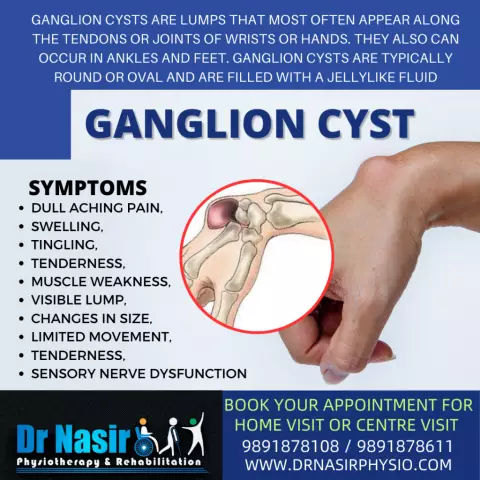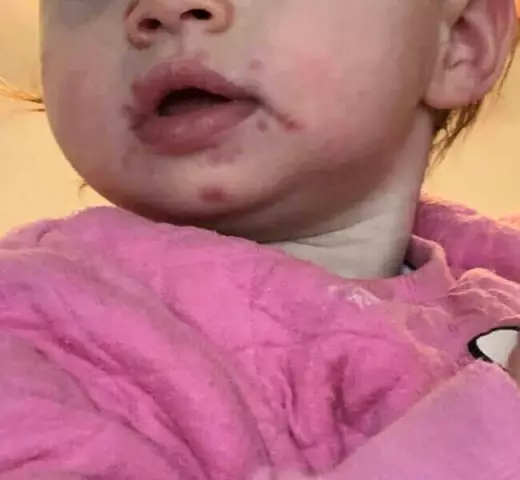- Author Rachel Wainwright [email protected].
- Public 2023-12-15 07:39.
- Last modified 2025-11-02 20:14.
Herpes zoster
The content of the article:
- Herpes zoster causes and risk group
- Forms of the disease
- Herpes zoster symptoms
- Diagnostics
- Treatment for herpes zoster
- Possible consequences of herpes zoster and complications
- Forecast
- Prevention
Herpes zoster (herpes zoster) is a disease caused by the Varicella zoster virus and manifested by unilateral skin rashes of a herpetiform nature, which are accompanied by severe pain syndrome.

Source: bezboleznej.ru
Given that the virus causes damage not only to the skin, but also to the peripheral nerves, the treatment of herpes zoster is carried out jointly by a dermatologist and a neurologist.
Despite the high contagiousness, the disease is observed in the form of sporadic, i.e., isolated cases. The incidence rate is 13-16 cases per 100,000 population. The peak is during the cold season. The risk group includes people of mature and old age who have previously had chickenpox. In children, herpes zoster is extremely rare.
The contagiousness of herpes zoster is confirmed by the fact that upon contact with a sick child, children who have not previously had chickenpox (i.e., do not have a formed immunity to Varicella zoster) become ill with it.
Herpes zoster causes and risk group
The causative agent of herpes zoster is herpesvirus Varicella zoster (herpes zoster virus type 3).
The first contact with this virus usually occurs for the first time in childhood, which leads to the development of chickenpox. After a disease, the virus remains in the cranial nerve ganglia and spinal ganglia in a dormant, i.e. inactive state. Thus, the cause of herpes zoster lies in the persistence of the Varicella zoster virus, the reactivation of which under the influence of various reasons leads to the development of the disease. The exact triggers of the awakening of the Varicella zoster virus remain not fully understood, however, it is known that a decrease in cellular immunity is a predisposing factor for reactivation. It accompanies the following conditions:
- acute respiratory viral infections;
- severe infectious and somatic diseases;
- chronic physical or mental fatigue;
- severe acute stress;
- therapy with drugs that suppress the activity of the immune system (immunosuppressants, corticosteroids, antibiotics, etc.);
- oncological diseases;
- condition after radiation therapy;
- severe injuries;
- addiction;
- HIV infection.

Source: lemur59.ru
Forms of the disease
Depending on the characteristics of the clinical picture, the following forms of herpes zoster are distinguished:
- ganglionic;
- ocular;
- ear, or Hunt's syndrome;
- necrotic, or gangrenous;
- meningoencephalic.
Herpes zoster symptoms
Each clinical form of herpes zoster has its own manifestations.
The most commonly observed ganglionic form of herpes zoster, the symptoms of which are:
- acute onset;
- fever;
- headache and muscle pain;
- decreased appetite.
Rashes appear along the course of individual sensory nerves (most often in the chest area, i.e., intercostal nerves). Their appearance is preceded by an unbearable burning pain. Initially, pinkish spots with indistinct borders, 3-5 cm in diameter appear on the skin. After 18-24 hours (this period may be longer, up to 12 days), sharply painful vesicles appear on their background, bounded from healthy skin by a clear demarcation line. After their appearance, the pain decreases somewhat. Skin lesions usually disappear within 2-4 weeks, and the pain syndrome persists for several months, although it is less intense than at the onset of the disease.

Source: boleznikogi.com
With the ocular form of herpes zoster, the trigeminal (gasser) node is affected. The disease is characterized by a particularly severe course. The rash is localized along the branches of the trigeminal nerve and is located on the skin of the face, mucous membranes of the nose and eyes. Often, the eyeball is also involved in the pathological process.
Ear damage (Hunt syndrome) is caused by damage to the geniculate ganglion by the herpes virus. At the same time, rashes appear in the area of the auricle, in the external auditory canal. The incidence increases in proportion to the age of the patients. This form of herpes zoster is not detected in children under 10 years of age. In about 20% of cases, Hunt syndrome is diagnosed in people over the age of 90.
With the ear and eye form of the disease, in addition to local symptoms, there are also signs of general intoxication: fever, deterioration in general condition, weakness, headache, etc.
With a necrotic (gangrenous) form of herpes zoster, a deep lesion of the skin occurs, followed by the formation of rough scars. This type of disease develops in people with immune deficiency, presumably with the addition of a bacterial infection.
It is extremely rare that the meningoencephalitic form of herpes zoster is observed, characterized by an extremely severe course and in 60% of cases fatal. The disease manifests itself with ganglionic manifestations, and after 2-4 weeks symptoms of inflammation of the brain and its membranes join them.
Any form of herpes zoster can be accompanied by damage to the vegetative ganglia. Clinically, this is manifested by symptoms atypical for herpes zoster:
- unstable stools (constipation followed by diarrhea);
- delay in urination;
- Horner's syndrome (a disorder of the sympathetic innervation of the eyeball, which is characterized by dry skin of the face from the side of the lesion, retraction of the eyeball, narrowing of the palpebral fissure and constriction of the pupil);
- vasomotor disorders.
Diagnostics
The diagnosis of herpes zoster is usually straightforward and is carried out on the basis of a pronounced clinical picture of the disease. If necessary, a laboratory examination is carried out, which includes:
- microscopy of the discharge to detect Tzank cells;
- isolation of the herpes virus in cell culture;
- ELISA.
Differential diagnosis is carried out with the following diseases:
- eczema;
- erysipelas;
- superficial pyoderma;
- contact dermatitis;
- pleurisy, myocardial infarction, pancreatitis (with damage to the intercostal nerves).
Treatment for herpes zoster
The use of antiviral drugs in the first 48 hours after the onset of the onset of the skin rash helps to accelerate the elimination of the symptoms of herpes zoster. The early initiation of antiviral therapy is especially important in the case of a severe course of the disease, with the development of an ocular or meningoencephalitic form of pathology.
In case of severe pain syndrome, non-steroidal anti-inflammatory drugs, codeine are prescribed.
Locally, with a secondarily infected rash, Sulfargin ointment (sulfadiazine silver salt) is used.
Carrying out drug treatment of herpes zoster with acyclovir requires careful monitoring of renal excretory function.
Possible consequences of herpes zoster and complications
Herpes zoster, especially if treatment is not started on time, can lead to the development of serious complications:
- postherpetic neuralgia;
- meningoencephalitis;
- involvement in the pathological process of the structures of the eyeball;
- accession of a secondary bacterial infection;
- pneumonia;
- hepatitis;
- segmental myelitis;
- muscle weakness due to damage to peripheral nerves;
- Guillain-Barré syndrome (autoimmune damage to peripheral nerves);
- ulceration of the cornea;
- syndromes of lesions of the cranial nerves, especially the facial and optic.
Forecast
In most cases, herpes zoster resolves within 2-3 weeks. After a disease, postherpetic neuralgia often develops, which can persist for six months or more. The likelihood of developing postherpetic neuralgia increases with the age of patients: at 30-50 years old it is 4%, and after 80 years - 50%.
The consequences of herpes zoster are much more serious in case of damage to the eyes and brain. Viral meningoencephalitis is fatal in 60% of cases. The survivors develop severe long-term consequences (paresis and paralysis, mental impairment, permanent disability). The ocular form of herpes zoster can cause a decrease in vision, up to its complete loss.
Prevention
To prevent virus infection, the following measures are recommended:
- patients with chickenpox or herpes zoster should be isolated, especially from children;
- carefully observe the rules of personal hygiene (refusal to wear someone else's clothes, use someone else's towels, etc.).
Strengthening the immune system is of great importance in the prevention of herpes zoster:
- regular physical education;
- daily walks in the fresh air lasting at least an hour;
- hardening procedures (only during the period of full health);
- proper nutrition (including a significant amount of fresh fruits and vegetables in the diet, limiting fatty, fried and spicy foods, fast food, avoiding snacks on the go, eating dry food);
- night sleep lasting at least 8 hours;
- observance of the regime of alternation of work and rest.
YouTube video related to the article:

Elena Minkina Doctor anesthesiologist-resuscitator About the author
Education: graduated from the Tashkent State Medical Institute, specializing in general medicine in 1991. Repeatedly passed refresher courses.
Work experience: anesthesiologist-resuscitator of the city maternity complex, resuscitator of the hemodialysis department.
The information is generalized and provided for informational purposes only. At the first sign of illness, see your doctor. Self-medication is hazardous to health!






